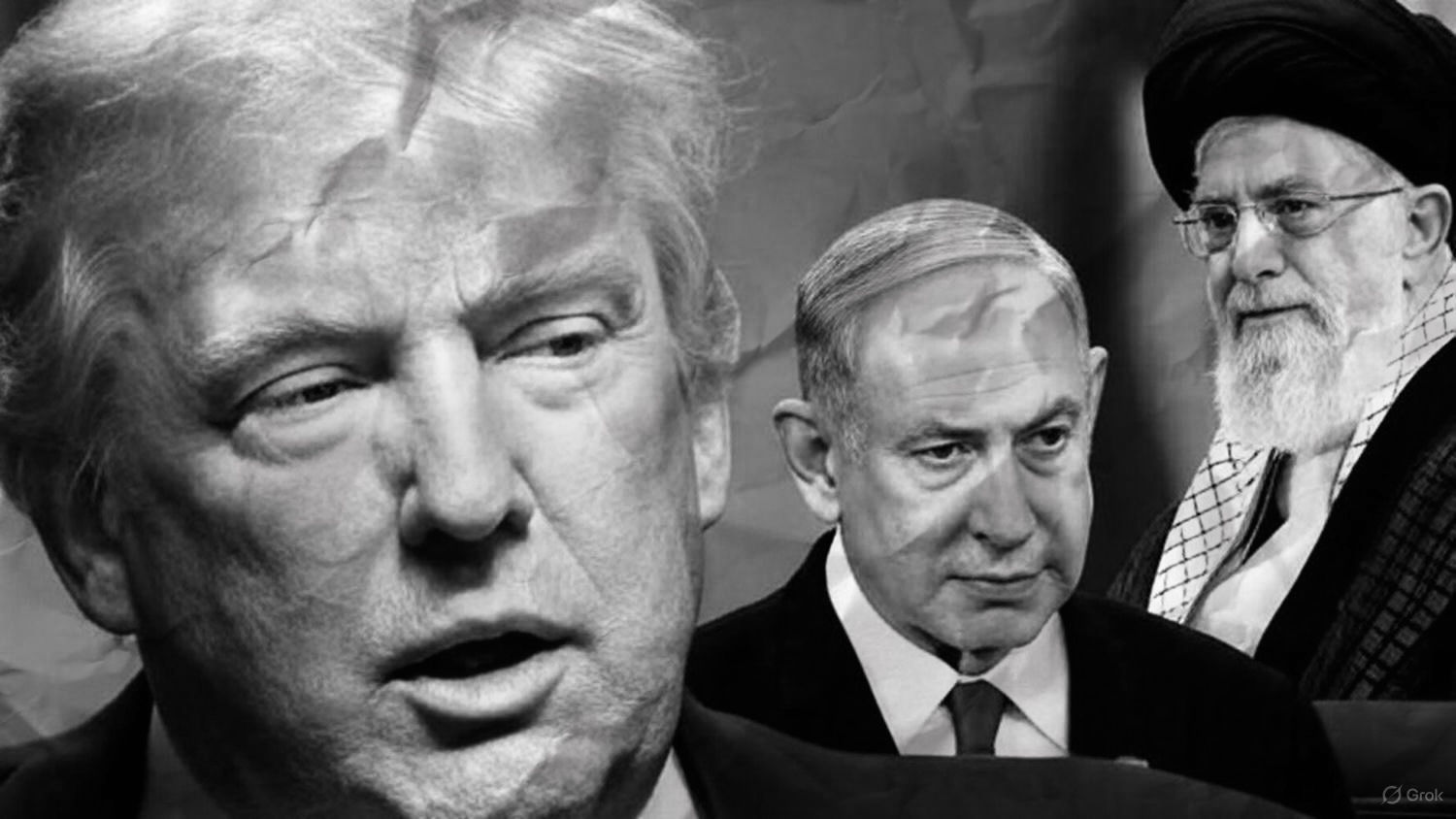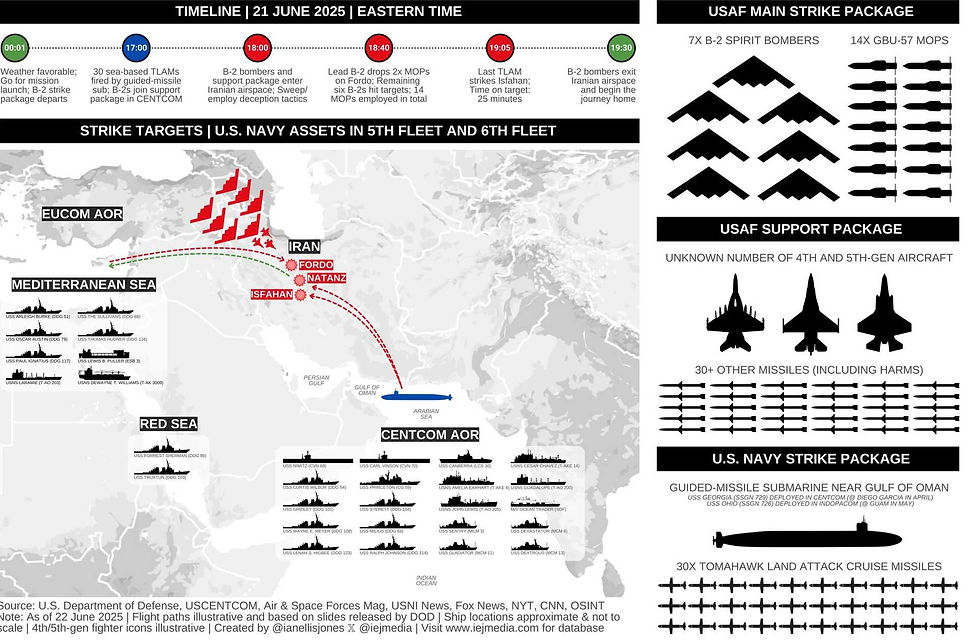
Nuclear Womb of Iran: Flashpoint in the Middle East
- Global-Gazette

- Jul 7
- 5 min read
MAYANK YADAV
In the midnight stroke of Israel over Iran’s key critical infrastructure on 13 June 2025, another round of anarchy was escalated in the current world order more specifically in the Middle East. However, it is often argued that the current conflict between Iran and Israel took a cue from the October 7 terrorist attack on Israel by Hamas (a proxy of Iran). The entanglement of the conflict has now reached a certain escalation ladder where the USA had to enter and bomb Iran using B-2 bombers, targeting three key nuclear facilities i.e, Fordo, Natanz, and Isfahan.

In this article, we will briefly discuss the historical dynamics of Iran’s nuclear programme, its willingness to develop nuclear weapons and the aversion from Israel’s side, and the power dynamics of the recent 12-day Iran-Israel war.
History of Iran and Israel’s Nuclear Programs:
The recent Operation Midnight Hammer by the USA on Iran marked an ironically historic moment. The genesis of Iran’s nuclear program was supported and established by the United States and its allies under President Eisenhower (1960s) through the Atoms for Peace program, aimed at countering Soviet hegemony during the Cold War. Also, the erstwhile regime of Iran was backed by MI6 and the CIA, which laid the groundwork for Iran to obtain nuclear technology.
However, the Islamic Revolution of the late 1970s, which overthrew Iran’s monarchy and established the Islamic Republic of Iran under Ayatollah Khomeini, destroyed Iran’s relations with the U.S. and Israel. The luxury of having a friendly Iran ended and turned into one of the most hostile relations in the Middle East. The new regime cut off ties and terminated several development projects, including the nuclear programme supported by the West. The lowest point in Iran–U.S. relations was marked by the 1979 Iran Hostage Crisis.
Israel began exploring nuclear technology soon after its founding in 1948. France was the initial partner, helping Israel build its first nuclear facility the Dimona nuclear reactor, under a secret pact in the 1950s, providing both technology and technical expertise. Given the hostile borders and regional dynamics, which Israel considered existential threats, it developed nuclear weapons in the 1960s. Israel follows a policy of denial and nuclear ambiguity, i.e., it doesn’t publicly acknowledge its arsenal, though it is well known through reports and leaks like the Vanunu revelations. During the Yom Kippur War (1973) against Egypt and Syria, Israel prepared its nuclear weapons as a last resort, which compelled U.S. military intervention to prevent escalation. Since then, Israel has followed its Samson
Option, a doctrine meant to instil fear in enemies by signaling a readiness to use nuclear weapons if the state’s existence is threatened.
Iran and Israel’s nuclear developments took place during a time when both shared a collusive relationship with the United States. Iran, in the 1970s, even went a step further and signed the NPT, which prohibited it from developing nuclear weapons. However, Israel remained skeptical of the NPT regime and never signed it, despite developing a nuclear arsenal. The Islamic revolution ended Israel’s strategic depth in Iran, marking the beginning of a hostile Iran–Israel relationship and the enduring Middle East crisis.
In 2015, after extensive diplomatic efforts by the Obama administration, along with the United Kingdom, France, Russia, China, and Germany, and with the support of the European Union, Iran was brought to an agreement known as the Joint Comprehensive Plan of Action (JCPOA). The primary aim of the deal was to prevent Iran from developing nuclear weapons by placing strict limits on its nuclear program, in exchange for the lifting of international economic sanctions. However, in 2018, the United States under President Donald Trump unilaterally withdrew from the deal, calling it “defective,” and reimposed sanctions on Iran. Since then, Iran has disassociated itself from any negotiations regarding the limitations on its nuclear program, viewing nuclear development as essential for its national security.
Also, the vertical asymmetry in defence capabilities where one is nuclear have and the other is have not has pushed Tehran to pursue nuclear weapons. In sum, nuclear fear between Iran and Israel has thrown the region into turmoil: Iran seeks to end its vulnerability by developing nuclear weapons, while Israel fears a nuclear Iran as an existential threat.
War of Attrition and Nuclear Deterrence:
Attrition warfare is not new to the Middle East. Powers like the U.S. and Soviet Union played in the region for decades during the Cold War, with Iraq and Syria as testaments to that history. Iran lacks nuclear deterrence vis-à-vis Israel. Hence, it has used proxies like Hezbollah and Hamas to countervail and circumvent Israeli power from its borders. The most notable example is the October 7, 2023 terrorist attack by Hamas, which became the immediate flashpoint in the current crisis.
On the other side, Israel developed nuclear weapons as a medium of deterrence to ensure its existence. With small geography and a small population, Israel sees nuclear security as essential to its survival. Iran’s Islamic government dares to develop nuclear arms in order to nullify the regional nuclear imbalance and gain a comprehensive upper hand, especially against Israel.
Thus, the limitations of attrition warfare and Iran’s defense inequality have compelled it to pursue nuclear weapons something the U.S. and Israel perceive as a direct threat. Therefore, Israel and the U.S. attacked Iran’s nuclear program while it was still in its womb stage, fearing that a nuclear Iran would alter the regional balance, peace, and non-proliferation regime irreversibly.
Implications of the Crisis in the Middle East:
In a globalized world, a war anywhere has an impact almost everywhere. The Russia–Ukraine war proved this. A major crisis in the Middle East would have several ripple effects:
• It would negatively affect the U.S.’s long-term strategy to contain China’s global rise and its Indo-Pacific strategy.
• Direct or indirect U.S. involvement in war with Iran will put a heavy load on its defense infrastructure. For instance, the U.S. produces only around 550 Patriot missile systems per year.
• Oil prices will surge, raising the risk of a global recession, especially due to Iranian control over the Strait of Hormuz and threats near the Gulf of Aden, both are key strategic choke points for global economy.
• Escalation may push Iran to attack facilities of U.S. allies like Saudi Arabia, UAE, and Qatar.
• It could lead to the failure of the NPT regime and disincentivize denuclearization globally by setting a wrong example: countries without nuclear arms are more vulnerable.
• A nuclear arms race may make global institutions (like the UN) more dysfunctional.
• The war could obliterate key logistic corridors like IMEC (India–Middle East–Europe Corridor) and INSTC (International North–South Transport Corridor).
The loop of military operations between Israel and Iran, ending with the conclusive Operation Midnight Hammer by the U.S., and Iran’s manufactured retaliation on U.S. bases in Qatar, has only resulted in a temporary truce. But in the long run, the window for peace remains small. Both Iran and Israel cannot afford a prolonged war. Iran’s ballistic capabilities exhausted Israel’s air defense and created havoc in Tel Aviv. Meanwhile, Israel and the U.S.’s repeated strikes on Iran’s critical infrastructure pushed Iran to seek peace to avoid the catastrophic destruction of Tehran.
The Road to Everlasting Peace:
A permanent peace between Iran and Israel can only exist if both sides sign a comprehensive peace accord that addresses mutual interests:
• For Iran: the right to self-determination for Palestine (through a real two-state solution), inclusion of Israel in the NPT, and the lifting of Western sanctions.
• For Israel: a non-nuclear Iran, and dismantling of Iranian proxies like Hezbollah and Hamas, and geographical expansion of Israel.
However, such an accord remains a political folklore under current conditions, especially with the increasing involvement of China and Russia, who back Iran and have further complicated the Middle East puzzle.





Thanks for an excellent insight, Mayank.